Intermediate Financial Accounting: Analyzing Entity Performance (XYZ)
VerifiedAdded on 2023/04/11
|7
|1484
|277
Report
AI Summary
This report provides an in-depth analysis of entity performance within the framework of General Purpose Financial Reporting (GPFR). It discusses the importance of GPFR in providing investors and other users with necessary financial information for decision-making. The report evaluates the pe...
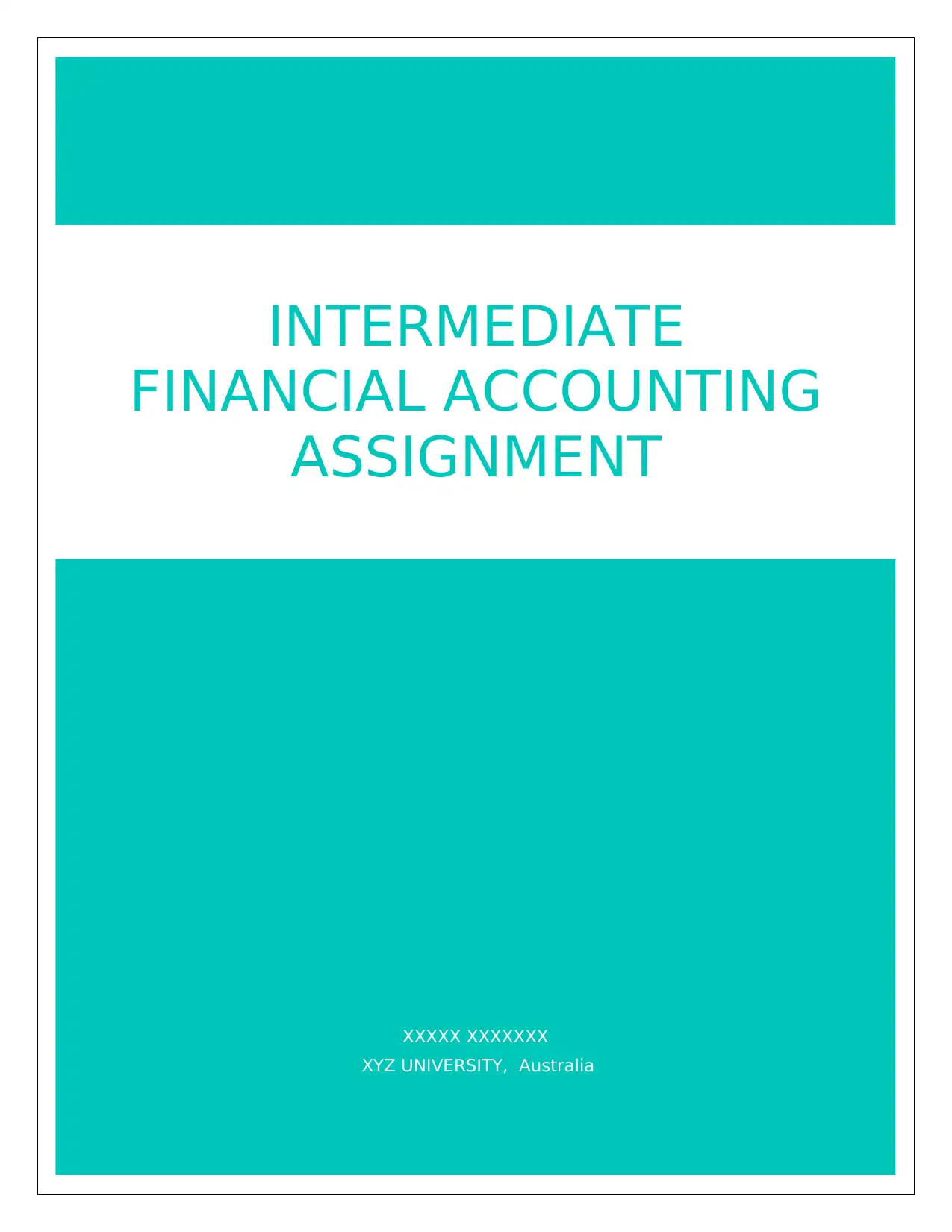
XXXXX XXXXXXX
XYZ UNIVERSITY, Australia
INTERMEDIATE
FINANCIAL ACCOUNTING
ASSIGNMENT
XYZ UNIVERSITY, Australia
INTERMEDIATE
FINANCIAL ACCOUNTING
ASSIGNMENT
Secure Best Marks with AI Grader
Need help grading? Try our AI Grader for instant feedback on your assignments.
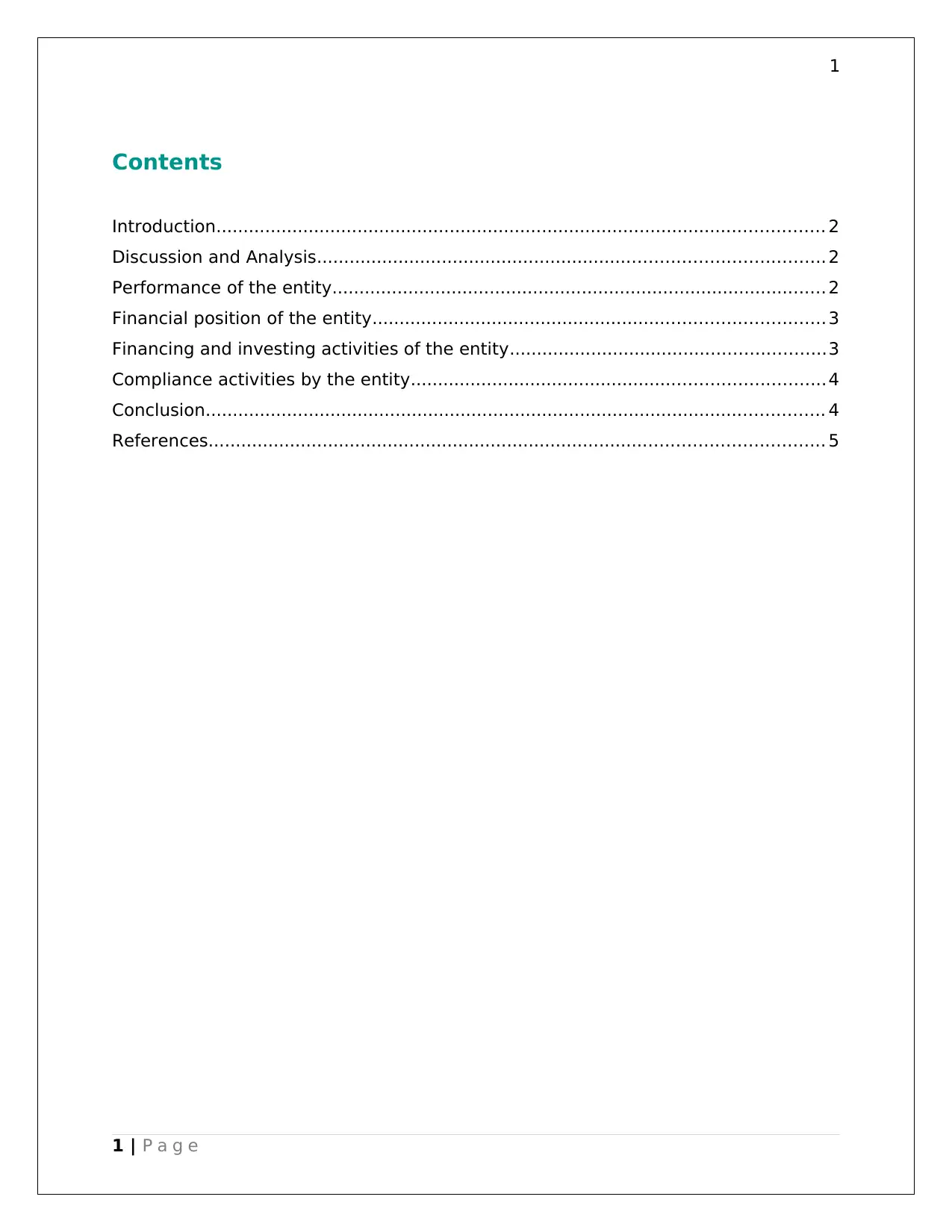
1
Contents
Introduction................................................................................................................ 2
Discussion and Analysis............................................................................................. 2
Performance of the entity........................................................................................... 2
Financial position of the entity................................................................................... 3
Financing and investing activities of the entity..........................................................3
Compliance activities by the entity............................................................................4
Conclusion.................................................................................................................. 4
References................................................................................................................. 5
1 | P a g e
Contents
Introduction................................................................................................................ 2
Discussion and Analysis............................................................................................. 2
Performance of the entity........................................................................................... 2
Financial position of the entity................................................................................... 3
Financing and investing activities of the entity..........................................................3
Compliance activities by the entity............................................................................4
Conclusion.................................................................................................................. 4
References................................................................................................................. 5
1 | P a g e
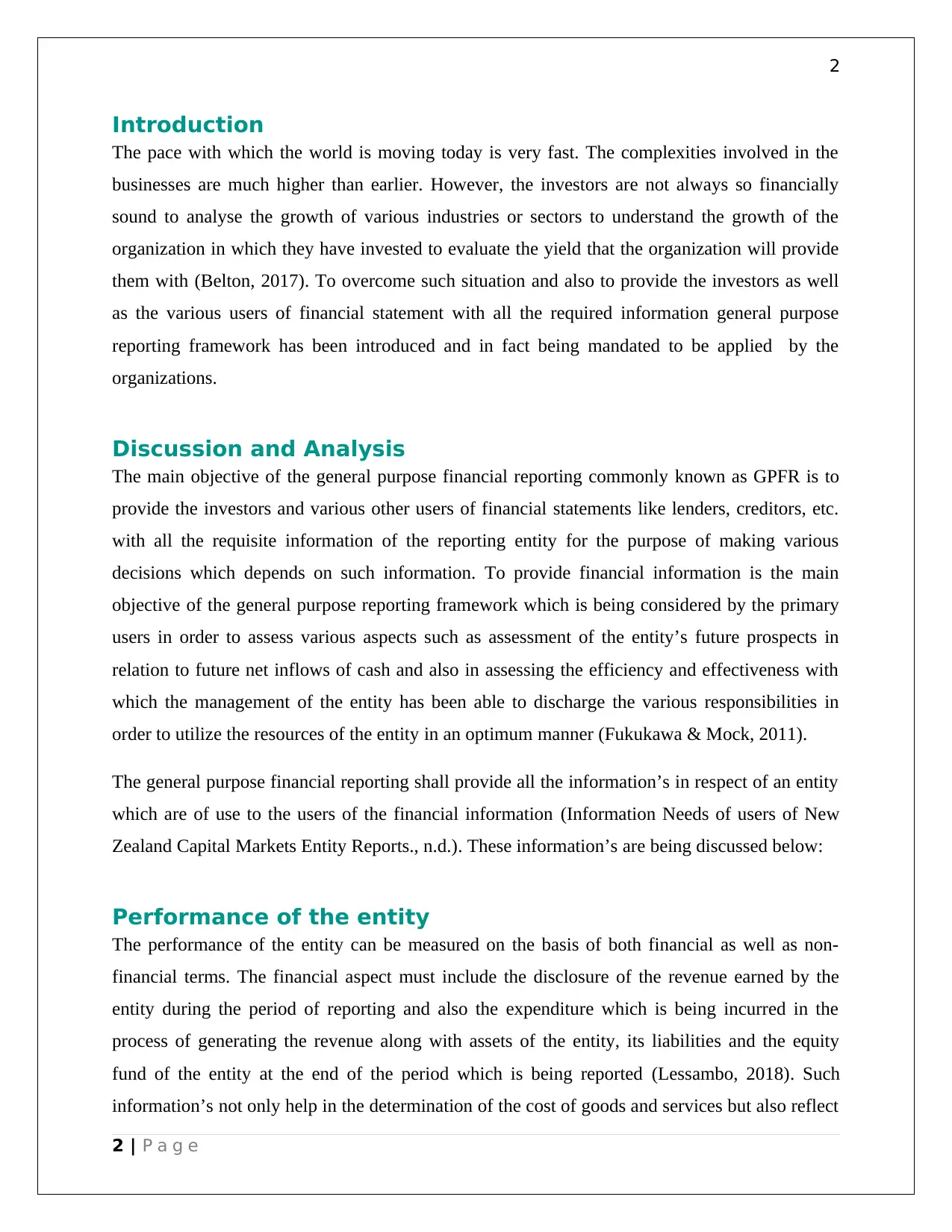
2
Introduction
The pace with which the world is moving today is very fast. The complexities involved in the
businesses are much higher than earlier. However, the investors are not always so financially
sound to analyse the growth of various industries or sectors to understand the growth of the
organization in which they have invested to evaluate the yield that the organization will provide
them with (Belton, 2017). To overcome such situation and also to provide the investors as well
as the various users of financial statement with all the required information general purpose
reporting framework has been introduced and in fact being mandated to be applied by the
organizations.
Discussion and Analysis
The main objective of the general purpose financial reporting commonly known as GPFR is to
provide the investors and various other users of financial statements like lenders, creditors, etc.
with all the requisite information of the reporting entity for the purpose of making various
decisions which depends on such information. To provide financial information is the main
objective of the general purpose reporting framework which is being considered by the primary
users in order to assess various aspects such as assessment of the entity’s future prospects in
relation to future net inflows of cash and also in assessing the efficiency and effectiveness with
which the management of the entity has been able to discharge the various responsibilities in
order to utilize the resources of the entity in an optimum manner (Fukukawa & Mock, 2011).
The general purpose financial reporting shall provide all the information’s in respect of an entity
which are of use to the users of the financial information (Information Needs of users of New
Zealand Capital Markets Entity Reports., n.d.). These information’s are being discussed below:
Performance of the entity
The performance of the entity can be measured on the basis of both financial as well as non-
financial terms. The financial aspect must include the disclosure of the revenue earned by the
entity during the period of reporting and also the expenditure which is being incurred in the
process of generating the revenue along with assets of the entity, its liabilities and the equity
fund of the entity at the end of the period which is being reported (Lessambo, 2018). Such
information’s not only help in the determination of the cost of goods and services but also reflect
2 | P a g e
Introduction
The pace with which the world is moving today is very fast. The complexities involved in the
businesses are much higher than earlier. However, the investors are not always so financially
sound to analyse the growth of various industries or sectors to understand the growth of the
organization in which they have invested to evaluate the yield that the organization will provide
them with (Belton, 2017). To overcome such situation and also to provide the investors as well
as the various users of financial statement with all the required information general purpose
reporting framework has been introduced and in fact being mandated to be applied by the
organizations.
Discussion and Analysis
The main objective of the general purpose financial reporting commonly known as GPFR is to
provide the investors and various other users of financial statements like lenders, creditors, etc.
with all the requisite information of the reporting entity for the purpose of making various
decisions which depends on such information. To provide financial information is the main
objective of the general purpose reporting framework which is being considered by the primary
users in order to assess various aspects such as assessment of the entity’s future prospects in
relation to future net inflows of cash and also in assessing the efficiency and effectiveness with
which the management of the entity has been able to discharge the various responsibilities in
order to utilize the resources of the entity in an optimum manner (Fukukawa & Mock, 2011).
The general purpose financial reporting shall provide all the information’s in respect of an entity
which are of use to the users of the financial information (Information Needs of users of New
Zealand Capital Markets Entity Reports., n.d.). These information’s are being discussed below:
Performance of the entity
The performance of the entity can be measured on the basis of both financial as well as non-
financial terms. The financial aspect must include the disclosure of the revenue earned by the
entity during the period of reporting and also the expenditure which is being incurred in the
process of generating the revenue along with assets of the entity, its liabilities and the equity
fund of the entity at the end of the period which is being reported (Lessambo, 2018). Such
information’s not only help in the determination of the cost of goods and services but also reflect
2 | P a g e
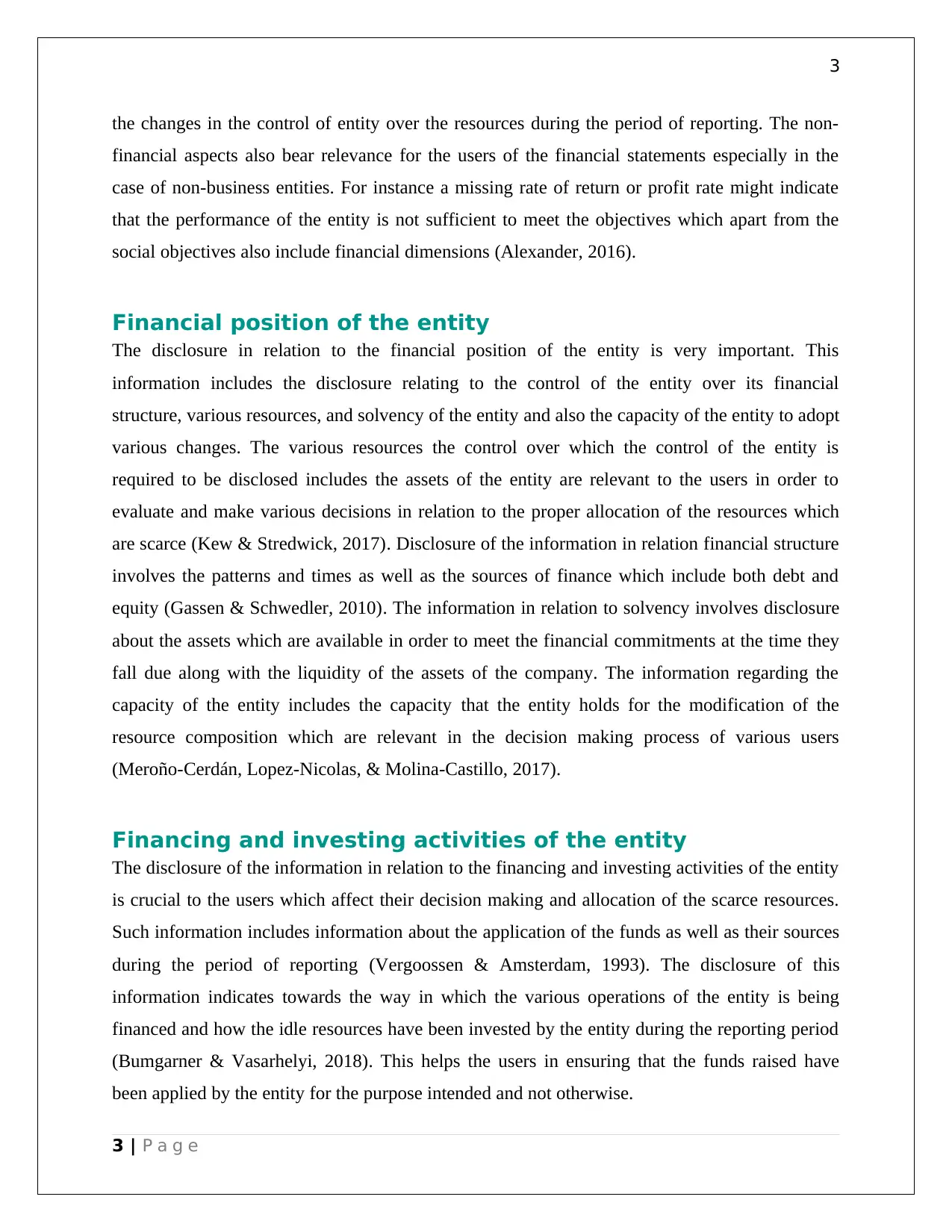
3
the changes in the control of entity over the resources during the period of reporting. The non-
financial aspects also bear relevance for the users of the financial statements especially in the
case of non-business entities. For instance a missing rate of return or profit rate might indicate
that the performance of the entity is not sufficient to meet the objectives which apart from the
social objectives also include financial dimensions (Alexander, 2016).
Financial position of the entity
The disclosure in relation to the financial position of the entity is very important. This
information includes the disclosure relating to the control of the entity over its financial
structure, various resources, and solvency of the entity and also the capacity of the entity to adopt
various changes. The various resources the control over which the control of the entity is
required to be disclosed includes the assets of the entity are relevant to the users in order to
evaluate and make various decisions in relation to the proper allocation of the resources which
are scarce (Kew & Stredwick, 2017). Disclosure of the information in relation financial structure
involves the patterns and times as well as the sources of finance which include both debt and
equity (Gassen & Schwedler, 2010). The information in relation to solvency involves disclosure
about the assets which are available in order to meet the financial commitments at the time they
fall due along with the liquidity of the assets of the company. The information regarding the
capacity of the entity includes the capacity that the entity holds for the modification of the
resource composition which are relevant in the decision making process of various users
(Meroño-Cerdán, Lopez-Nicolas, & Molina-Castillo, 2017).
Financing and investing activities of the entity
The disclosure of the information in relation to the financing and investing activities of the entity
is crucial to the users which affect their decision making and allocation of the scarce resources.
Such information includes information about the application of the funds as well as their sources
during the period of reporting (Vergoossen & Amsterdam, 1993). The disclosure of this
information indicates towards the way in which the various operations of the entity is being
financed and how the idle resources have been invested by the entity during the reporting period
(Bumgarner & Vasarhelyi, 2018). This helps the users in ensuring that the funds raised have
been applied by the entity for the purpose intended and not otherwise.
3 | P a g e
the changes in the control of entity over the resources during the period of reporting. The non-
financial aspects also bear relevance for the users of the financial statements especially in the
case of non-business entities. For instance a missing rate of return or profit rate might indicate
that the performance of the entity is not sufficient to meet the objectives which apart from the
social objectives also include financial dimensions (Alexander, 2016).
Financial position of the entity
The disclosure in relation to the financial position of the entity is very important. This
information includes the disclosure relating to the control of the entity over its financial
structure, various resources, and solvency of the entity and also the capacity of the entity to adopt
various changes. The various resources the control over which the control of the entity is
required to be disclosed includes the assets of the entity are relevant to the users in order to
evaluate and make various decisions in relation to the proper allocation of the resources which
are scarce (Kew & Stredwick, 2017). Disclosure of the information in relation financial structure
involves the patterns and times as well as the sources of finance which include both debt and
equity (Gassen & Schwedler, 2010). The information in relation to solvency involves disclosure
about the assets which are available in order to meet the financial commitments at the time they
fall due along with the liquidity of the assets of the company. The information regarding the
capacity of the entity includes the capacity that the entity holds for the modification of the
resource composition which are relevant in the decision making process of various users
(Meroño-Cerdán, Lopez-Nicolas, & Molina-Castillo, 2017).
Financing and investing activities of the entity
The disclosure of the information in relation to the financing and investing activities of the entity
is crucial to the users which affect their decision making and allocation of the scarce resources.
Such information includes information about the application of the funds as well as their sources
during the period of reporting (Vergoossen & Amsterdam, 1993). The disclosure of this
information indicates towards the way in which the various operations of the entity is being
financed and how the idle resources have been invested by the entity during the reporting period
(Bumgarner & Vasarhelyi, 2018). This helps the users in ensuring that the funds raised have
been applied by the entity for the purpose intended and not otherwise.
3 | P a g e
Secure Best Marks with AI Grader
Need help grading? Try our AI Grader for instant feedback on your assignments.
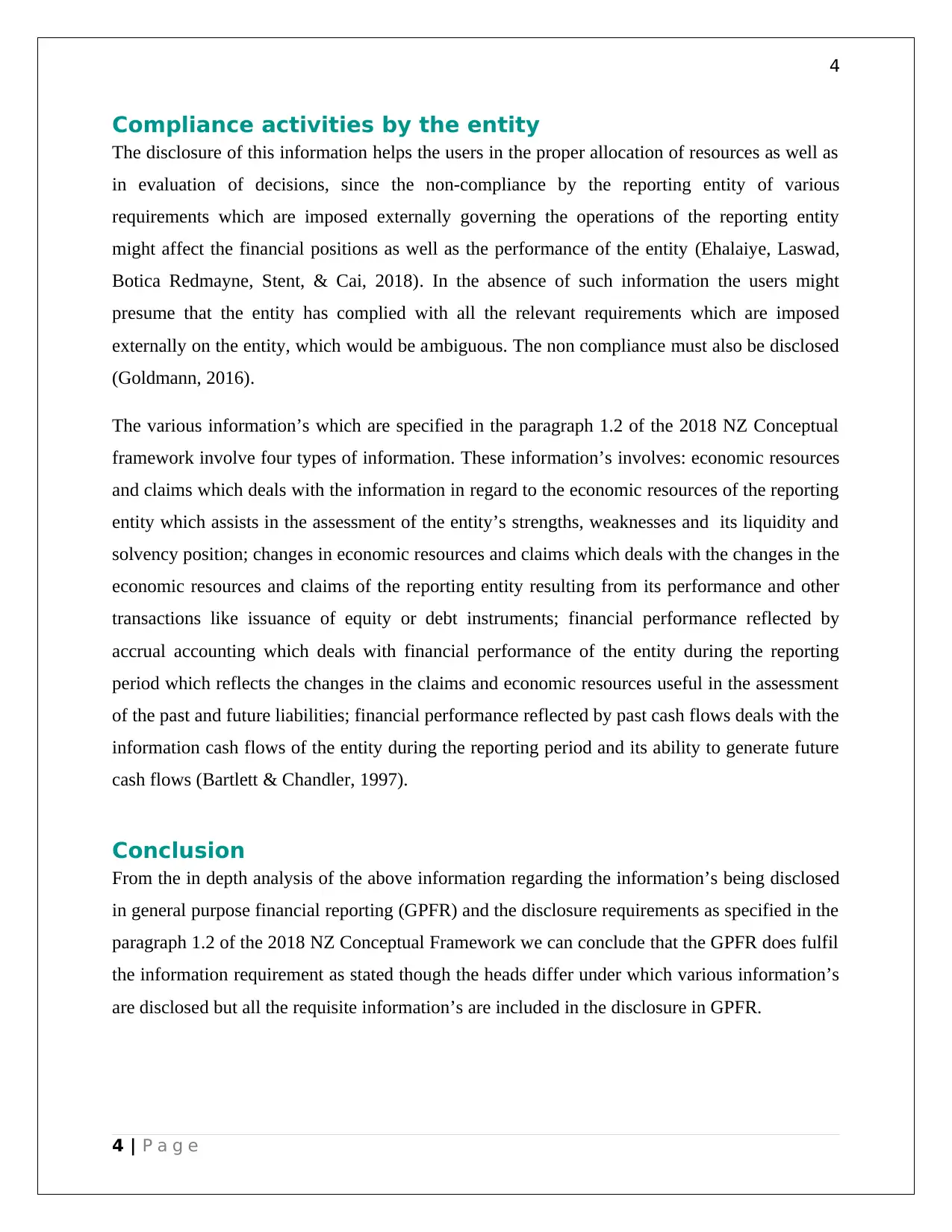
4
Compliance activities by the entity
The disclosure of this information helps the users in the proper allocation of resources as well as
in evaluation of decisions, since the non-compliance by the reporting entity of various
requirements which are imposed externally governing the operations of the reporting entity
might affect the financial positions as well as the performance of the entity (Ehalaiye, Laswad,
Botica Redmayne, Stent, & Cai, 2018). In the absence of such information the users might
presume that the entity has complied with all the relevant requirements which are imposed
externally on the entity, which would be ambiguous. The non compliance must also be disclosed
(Goldmann, 2016).
The various information’s which are specified in the paragraph 1.2 of the 2018 NZ Conceptual
framework involve four types of information. These information’s involves: economic resources
and claims which deals with the information in regard to the economic resources of the reporting
entity which assists in the assessment of the entity’s strengths, weaknesses and its liquidity and
solvency position; changes in economic resources and claims which deals with the changes in the
economic resources and claims of the reporting entity resulting from its performance and other
transactions like issuance of equity or debt instruments; financial performance reflected by
accrual accounting which deals with financial performance of the entity during the reporting
period which reflects the changes in the claims and economic resources useful in the assessment
of the past and future liabilities; financial performance reflected by past cash flows deals with the
information cash flows of the entity during the reporting period and its ability to generate future
cash flows (Bartlett & Chandler, 1997).
Conclusion
From the in depth analysis of the above information regarding the information’s being disclosed
in general purpose financial reporting (GPFR) and the disclosure requirements as specified in the
paragraph 1.2 of the 2018 NZ Conceptual Framework we can conclude that the GPFR does fulfil
the information requirement as stated though the heads differ under which various information’s
are disclosed but all the requisite information’s are included in the disclosure in GPFR.
4 | P a g e
Compliance activities by the entity
The disclosure of this information helps the users in the proper allocation of resources as well as
in evaluation of decisions, since the non-compliance by the reporting entity of various
requirements which are imposed externally governing the operations of the reporting entity
might affect the financial positions as well as the performance of the entity (Ehalaiye, Laswad,
Botica Redmayne, Stent, & Cai, 2018). In the absence of such information the users might
presume that the entity has complied with all the relevant requirements which are imposed
externally on the entity, which would be ambiguous. The non compliance must also be disclosed
(Goldmann, 2016).
The various information’s which are specified in the paragraph 1.2 of the 2018 NZ Conceptual
framework involve four types of information. These information’s involves: economic resources
and claims which deals with the information in regard to the economic resources of the reporting
entity which assists in the assessment of the entity’s strengths, weaknesses and its liquidity and
solvency position; changes in economic resources and claims which deals with the changes in the
economic resources and claims of the reporting entity resulting from its performance and other
transactions like issuance of equity or debt instruments; financial performance reflected by
accrual accounting which deals with financial performance of the entity during the reporting
period which reflects the changes in the claims and economic resources useful in the assessment
of the past and future liabilities; financial performance reflected by past cash flows deals with the
information cash flows of the entity during the reporting period and its ability to generate future
cash flows (Bartlett & Chandler, 1997).
Conclusion
From the in depth analysis of the above information regarding the information’s being disclosed
in general purpose financial reporting (GPFR) and the disclosure requirements as specified in the
paragraph 1.2 of the 2018 NZ Conceptual Framework we can conclude that the GPFR does fulfil
the information requirement as stated though the heads differ under which various information’s
are disclosed but all the requisite information’s are included in the disclosure in GPFR.
4 | P a g e
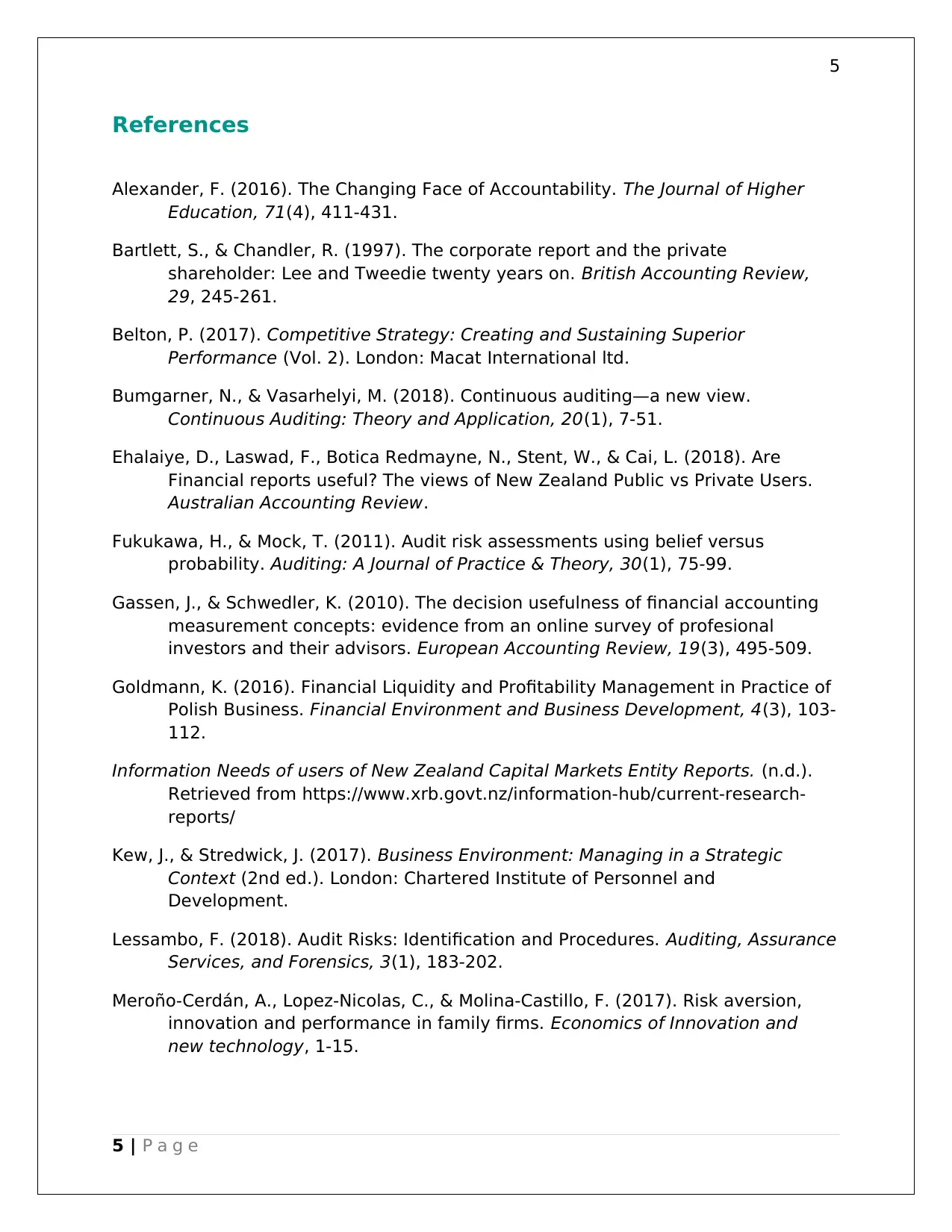
5
References
Alexander, F. (2016). The Changing Face of Accountability. The Journal of Higher
Education, 71(4), 411-431.
Bartlett, S., & Chandler, R. (1997). The corporate report and the private
shareholder: Lee and Tweedie twenty years on. British Accounting Review,
29, 245-261.
Belton, P. (2017). Competitive Strategy: Creating and Sustaining Superior
Performance (Vol. 2). London: Macat International ltd.
Bumgarner, N., & Vasarhelyi, M. (2018). Continuous auditing—a new view.
Continuous Auditing: Theory and Application, 20(1), 7-51.
Ehalaiye, D., Laswad, F., Botica Redmayne, N., Stent, W., & Cai, L. (2018). Are
Financial reports useful? The views of New Zealand Public vs Private Users.
Australian Accounting Review.
Fukukawa, H., & Mock, T. (2011). Audit risk assessments using belief versus
probability. Auditing: A Journal of Practice & Theory, 30(1), 75-99.
Gassen, J., & Schwedler, K. (2010). The decision usefulness of financial accounting
measurement concepts: evidence from an online survey of profesional
investors and their advisors. European Accounting Review, 19(3), 495-509.
Goldmann, K. (2016). Financial Liquidity and Profitability Management in Practice of
Polish Business. Financial Environment and Business Development, 4(3), 103-
112.
Information Needs of users of New Zealand Capital Markets Entity Reports. (n.d.).
Retrieved from https://www.xrb.govt.nz/information-hub/current-research-
reports/
Kew, J., & Stredwick, J. (2017). Business Environment: Managing in a Strategic
Context (2nd ed.). London: Chartered Institute of Personnel and
Development.
Lessambo, F. (2018). Audit Risks: Identification and Procedures. Auditing, Assurance
Services, and Forensics, 3(1), 183-202.
Meroño-Cerdán, A., Lopez-Nicolas, C., & Molina-Castillo, F. (2017). Risk aversion,
innovation and performance in family firms. Economics of Innovation and
new technology, 1-15.
5 | P a g e
References
Alexander, F. (2016). The Changing Face of Accountability. The Journal of Higher
Education, 71(4), 411-431.
Bartlett, S., & Chandler, R. (1997). The corporate report and the private
shareholder: Lee and Tweedie twenty years on. British Accounting Review,
29, 245-261.
Belton, P. (2017). Competitive Strategy: Creating and Sustaining Superior
Performance (Vol. 2). London: Macat International ltd.
Bumgarner, N., & Vasarhelyi, M. (2018). Continuous auditing—a new view.
Continuous Auditing: Theory and Application, 20(1), 7-51.
Ehalaiye, D., Laswad, F., Botica Redmayne, N., Stent, W., & Cai, L. (2018). Are
Financial reports useful? The views of New Zealand Public vs Private Users.
Australian Accounting Review.
Fukukawa, H., & Mock, T. (2011). Audit risk assessments using belief versus
probability. Auditing: A Journal of Practice & Theory, 30(1), 75-99.
Gassen, J., & Schwedler, K. (2010). The decision usefulness of financial accounting
measurement concepts: evidence from an online survey of profesional
investors and their advisors. European Accounting Review, 19(3), 495-509.
Goldmann, K. (2016). Financial Liquidity and Profitability Management in Practice of
Polish Business. Financial Environment and Business Development, 4(3), 103-
112.
Information Needs of users of New Zealand Capital Markets Entity Reports. (n.d.).
Retrieved from https://www.xrb.govt.nz/information-hub/current-research-
reports/
Kew, J., & Stredwick, J. (2017). Business Environment: Managing in a Strategic
Context (2nd ed.). London: Chartered Institute of Personnel and
Development.
Lessambo, F. (2018). Audit Risks: Identification and Procedures. Auditing, Assurance
Services, and Forensics, 3(1), 183-202.
Meroño-Cerdán, A., Lopez-Nicolas, C., & Molina-Castillo, F. (2017). Risk aversion,
innovation and performance in family firms. Economics of Innovation and
new technology, 1-15.
5 | P a g e
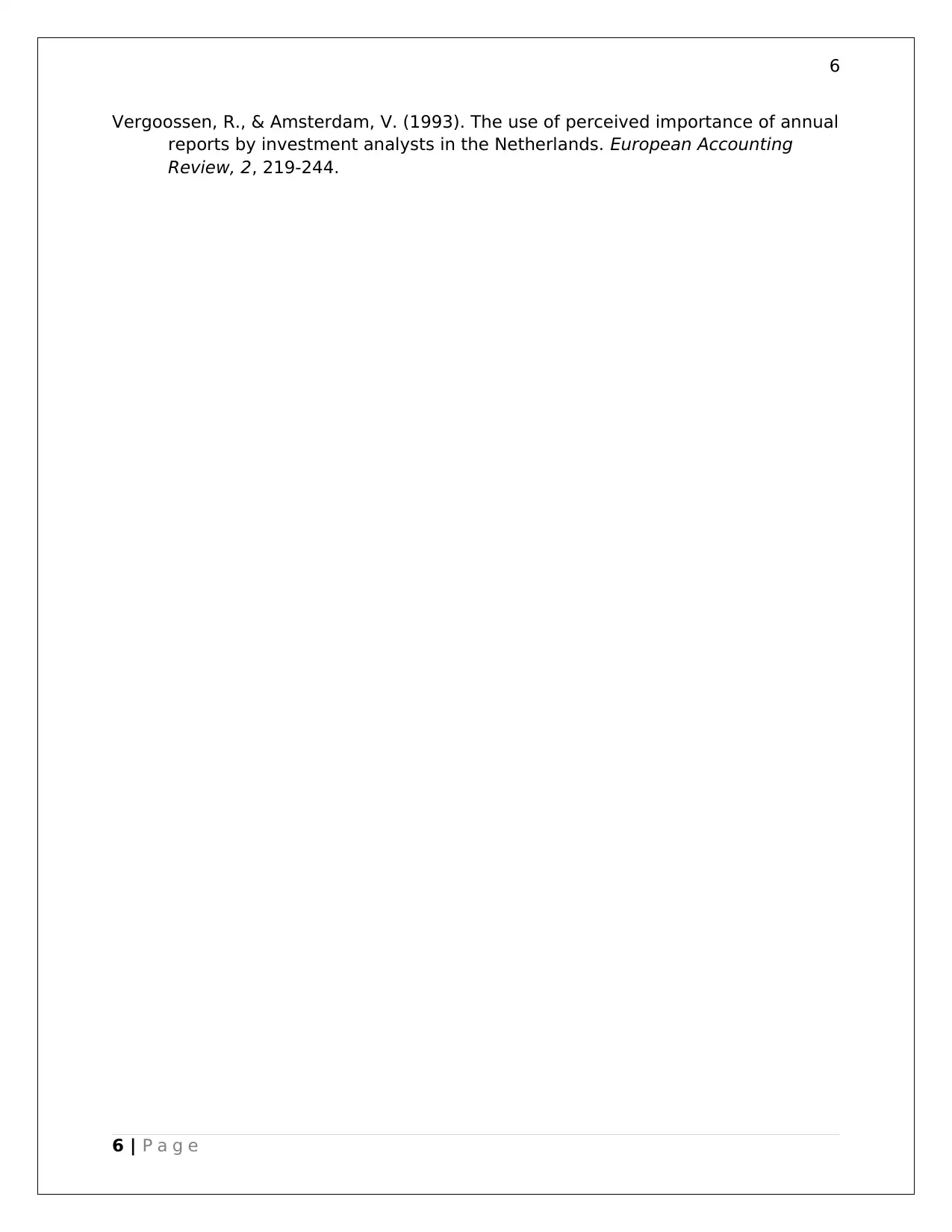
6
Vergoossen, R., & Amsterdam, V. (1993). The use of perceived importance of annual
reports by investment analysts in the Netherlands. European Accounting
Review, 2, 219-244.
6 | P a g e
Vergoossen, R., & Amsterdam, V. (1993). The use of perceived importance of annual
reports by investment analysts in the Netherlands. European Accounting
Review, 2, 219-244.
6 | P a g e
1 out of 7
Related Documents
Your All-in-One AI-Powered Toolkit for Academic Success.
+13062052269
info@desklib.com
Available 24*7 on WhatsApp / Email
![[object Object]](/_next/static/media/star-bottom.7253800d.svg)
Unlock your academic potential
© 2024 | Zucol Services PVT LTD | All rights reserved.




